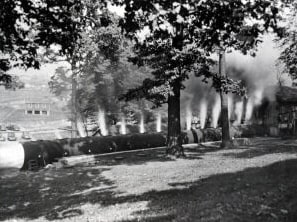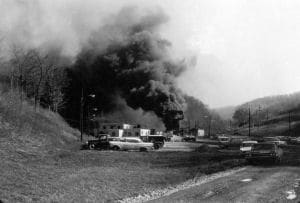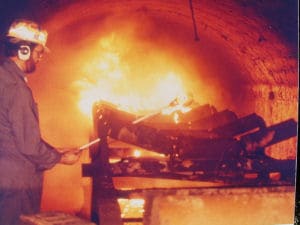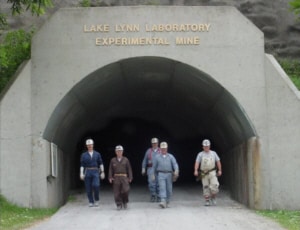History of the Mining Program
- Introduction
- The Birth of the U.S. Bureau of Mines (1910)
- The Early Years: Focus on Explosives and Disaster Research
- The Central Experiment Station (1917)
- Expansion of USBM Mission: Flames, Explosions, and Detonations (1936)
- Mining Research Begins in Spokane, Washington (1951)
- Developing Safer Explosives (1950s and 1960s)
- Significant USBM Contributions to Other Industries
- The Federal Coal Mine Health and Safety Act of 1969: USBM Mission Extended to Other Mining Safety and Health Issues
- Federal Mine Safety and Health Amendments Act of 1977
- Transfer of USBM Functions to MESA and ERDA (1970s)
- Acquisition of Lake Lynn Laboratory (1982)
Introduction
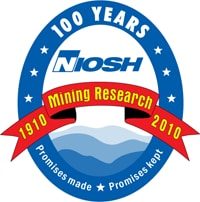
In 2010, the NIOSH Mining Program celebrated 100 years of mining research that started with the establishment of the U.S. Bureau of Mines in 1910.
This document describes the history of the mining research program, beginning with the establishment of the U.S. Bureau of Mines in 1910. It describes the evolution of the program and its accomplishments over the years, culminating in its transformation as the National Institute for Occupational Safety and Health in 1996 and the establishment of the National Personal Protective Technology Laboratory in 2001.
The Birth of the U.S. Bureau of Mines (1910)
For years prior to 1910, there were calls from many quarters to create in the federal government a bureau that would collect, evaluate, and disseminate scientific, technologic, and economic data of value to the mineral industries. The American Mining Congress, for example, proposed the creation of a federal Department of Mines at its 1896 annual convention. The conservation movement also envisioned a federal role in helping the nation use its mineral resources responsibly. Concern over the waste of both human and natural resources was reflected in President Theodore Roosevelt's recommendation in 1907 to establish a U.S. Bureau of Mines (USBM) in the Department of the Interior. Congress, however, did not act on this until a series of disasters in the nation's coal mines focused public attention on the loss of human life. These disasters took more than 3,000 lives in 1907 alone. There were 361 coal miners killed in Monongah, WV, on December 6, 1907; 239 killed two weeks later at Jacobs Creek, PA; 154 killed at Marianna, PA, on November 28, 1908; and 259 killed at Cherry, IL, on November 13, 1909.
The U.S. Geological Survey (USGS) of the Interior Department earlier had established a close relationship with the mining and mineral industries through the preparation and publication of its annual report on Mineral Industries of the United States. The USGS was also conducting studies in important mining areas. In 1899, the USGS Director recommended establishing a Division of Mines and Mining and, in 1904, Congress appropriated funds for analyzing and testing the coals of the United States. This led to the formation of the technologic branch, headed by Dr. Joseph A. Holmes, a former North Carolina state geologist and university professor. On May 16, 1910, Congress passed the Organic Act (Public Law 61-179) establishing the USBM. The act authorized the Secretary of the Interior to transfer to the new bureau the types of investigations heretofore conducted by the technologic branch of the USGS together with the pertinent personnel, equipment, and property. The USBM became functional on July 1, 1910. Shortly thereafter, Dr. Holmes was appointed its first director and served until his death in July 1915.
The Early Years: Focus on Explosives and Disaster Research
The original mission of the USBM was to provide the mining industry with information on blasting materials and techniques that could be used safely in the presence of flammable mine gases and dust. This meant identifying the chemical and physical characteristics that allowed explosives to perform usefully without initiating disastrous fires and explosions. These considerations defined the two main objectives of the USBM's initial research and development - safer blasting materials for underground coal mines, and prevention of underground mine gas and dust explosions.
Although administratively headquartered in Washington, DC, the principal research activities were conducted by the Pittsburgh Mining Experiment Station under Dr. Holmes. According to the Organic Act, the USBM was, among other things, "to make diligent investigation of the methods of mining, especially in relation to the safety of miners, the use of explosives, the prevention of accidents." This reflects the origin of what eventually became known as the Pittsburgh Research Center.
In establishing the USBM, Congress undoubtedly was mindful of similar test stations established earlier in England, Germany, Belgium, Austria, and France, whose work had done much to reduce the frequency and severity of coal mine accidents. Recognizing this, the Secretary of the Interior had requested a delegation of foreign experts to visit U.S. mines to make recommendations to improve safety and efficiency. Thus, the groundwork for the birth of the USBM had been laid.
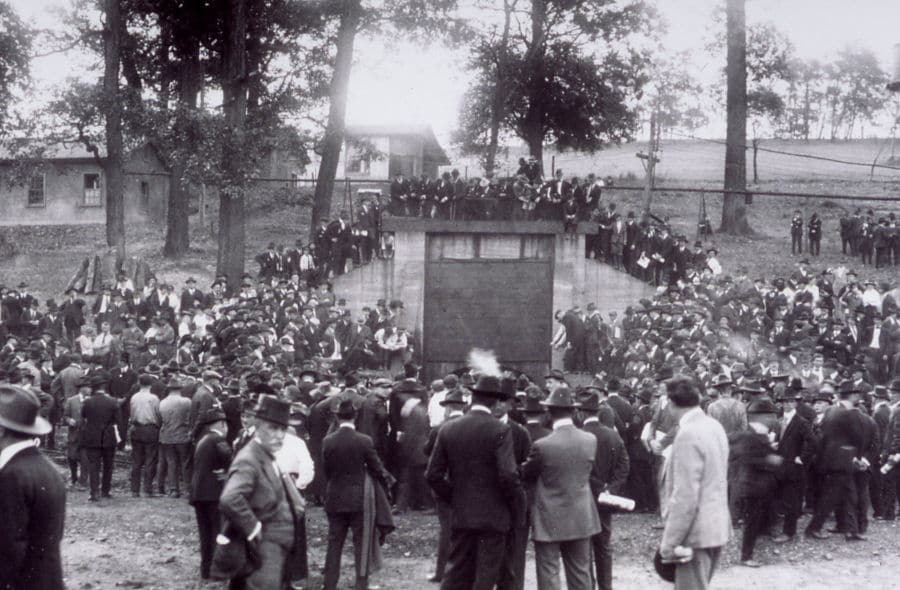
Dedication of the Experimental Mine, which opened in 1910.
The USBM's Pittsburgh Mining Experiment Station, as it was then called, was located at the Government Arsenal in the Lawrenceville section of Pittsburgh, where the War Department had graciously allotted a portion of grounds and buildings to the U.S. Geological Survey. A 100-foot-long test passage, or gallery, that simulated an underground coal mine entry had been installed at the arsenal. It was similar to galleries already established in Courrières, France, and Altofts, England. Although mainly intended to test explosives, it also became the site of numerous coal dust explosion demonstrations, which were necessary to alert the public as to the severity of such explosions. However, many observers were not convinced that a rather short gallery could recreate actual mine conditions. Accordingly, in 1910, the newly created USBM leased a 38-acre tract of land from the Pittsburgh Coal Co. in Bruceton, about 13 miles south of Pittsburgh. Here, a new mine, known as the Experimental Mine, was opened. One of the early experiments in the Experimental Mine demonstrated that coal dust by itself was capable of propagating an explosion even in the absence of any methane gas. This demonstration was contrary to the old belief widely held at the time that coal dust could not explode without gas. This view had led to the very dangerous and widespread practice of using loose coal dust in mines to pack explosives in boreholes, which had cost many thousands of lives. These early experiments clearly proved that such a practice was too hazardous to continue.
One of the first objectives of the new Pittsburgh Mining Experiment Station was to test and approve explosives whose detonation products had temperatures low enough and flames short enough in duration to be considered safe in flammable mine atmospheres. Such explosives were then classified as permissible, or approved, for use in coal mines. At first, there were no safe, permissible types of explosives nor certified permissible equipment of any kind for use in U.S. coal mines. To be classified as permissible for use in underground coal mines, explosives now had to pass a series of scheduled safety and performance tests.
In 1910, the following USBM projects were underway in Pittsburgh:
- Installation of equipment for testing explosives similar to that used in European testing stations, and certification as permissible of a number of "short-flame" U.S. explosives that had been developed by manufacturers for use in gassy coal mines;
- Operation of an electrical section to develop permissibility requirements for electrical equipment, safety lamps, and electrical types of methane indicators;
- Investigation of the occurrence of methane gas in U.S. coal mines and the adequacy of ventilation to prevent the accumulation of dangerous concentrations of the gas; and
- Lab research on the flammability of coal dust and quenching of flame by the presence of rock dust.
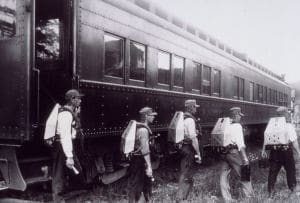
A Bureau of Mines mine safety railroad car equipped as a movable safety and rescue station.
In addition to work on safer blasting materials and prevention of underground gas and dust explosions, mine post-disaster survival and rescue was another concern of the young USBM. Director Holmes initiated the scheme of equipping railroad cars, one of which was headquartered at Pittsburgh, as movable safety and rescue stations. These cars - purchased second-hand, and refitted and equipped at a total cost of $5,000 each - toured the Nation's coalfields, training miners in first aid, rescue work, and mine safety. In a mining emergency, the cars could be immediately dispatched to the accident scene. On October 30-31, 1911, the first national mine safety demonstrations were held at Pittsburgh "as an object lesson to those who had not adopted first-aid instruction or instruction in the use of artificial breathing devices and life-saving apparatus." Nearly 2,000 persons witnessed the demonstrations and exhibits of the USBM at the Arsenal grounds on the morning of October 30, 1911. About 1,200 persons visited the USBM's Experimental Mine at Bruceton to observe a demonstration of the explosion of coal dust. At a public demonstration of mine rescue work on October 31, 1911, which was attended by President William H. Taft, about 15,000 persons, chiefly miners, were present. The demonstration took place at the former Forbes Baseball Field. President Taft handed Red Cross medals and first aid packages to the rescue team captains, saying: "We must stamp out the spirit of carelessness and the happy-go-lucky idea that I am afraid is too common with Americans generally."
At the Experimental Mine, work focused on identifying the processes associated with initiation, growth, and eventual extinguishment of mine fires and explosions. There, under conditions similar to those of a working mine, it was learned how weak methane explosions can initiate violent coal dust explosions and how rock dust, water, and other quenching agents can be applied to arrest these explosions. Instruments were developed for the early detection of open flames and incipient fires due to spontaneous combustion.
The Central Experiment Station (1917)
In 1917, a major landmark in the USBM's history occurred when the Pittsburgh Mining Experiment Station was moved from Lawrenceville to the newly constructed Central Experiment Station at 4800 Forbes Avenue, adjacent to what is now Carnegie Mellon University, in the Oakland section of Pittsburgh. For reasons of safety, the explosives testing activities were moved to Bruceton, where additional buildings were erected to house the Explosives Experiment Station, later to be known as the Explosives Testing Station. All of the land occupied by the USBM at that time, including the Experimental Mine, was purchased in 1924.
On June 4, 1925, President Calvin Coolidge issued an executive order creating the Department of Commerce and transferring the USBM and its employees, except those involved in oil-leasing work, into the new department effective July 1, 1925. The purpose of the transfer was to permit a closer coordination of USBM activities with related activities of the bureaus in Commerce. In 1934, the USBM was returned to the Department of the Interior by another executive order signed by President Franklin D. Roosevelt.
In 1928, Dr. Arno C. Fieldner, Chief Engineer, Experiment Stations Division, described the Pittsburgh Mining Experiment Station as consisting of:
- The health laboratory section charged with control of mine gases and dusts, disposal of mine waste waters, mine sealing against acid mine drainage, and catalytic treatment of automobile exhaust;
- The explosives section;
- The fuels section;
- The metallurgical section;
- The physical section;
- The Experimental Mine section;
- The mining research section; and
- The falls of roof and coal section.
Expansion of USBM Mission: Flames, Explosions, and Detonations (1936)
By 1936, research emphasis was placed on explosives, explosions, and combustion. Wilbert J. Huff was Chief of what was then known as the Explosives Division, followed by Dr. Bernard Lewis in 1946. Under Dr. Lewis' leadership, the division became the Explosives and Physical Sciences Division, and its function was substantially expanded to include fundamental research in the structure of flames, explosions, and detonations.
Over the years, the USBM sought to reduce the use of unsuitable explosives, as well as the improper use of explosives, through research, training, and demonstrational programs. The introduction of permissible explosives to the coal mining industry had been a major step in increasing safety in gassy and dusty coal mines. Even though these early permissible explosives met with initial acceptance by the coal mining industry, it required about 30 years of unceasing effort in the form of education and developmental endeavors before mounting acceptance of permissibles eclipsed the use of black powder, the principal blasting explosive used in underground coal mines, to which many mine disasters were directly attributed. Additionally, in 1948, after extensive experimentation, an increase in the permissible charge limit from 1½ to 3 pounds, as requested by the industry, was authorized, which greatly improved productivity. Also paralleling these developments was the introduction of water-filled stemming bags, single- and multiple-shot blasting machines, and short-delay detonators.
Mining Research Begins in Spokane, Washington (1951)
In April 1951, the USBM moved its Northwest Region's Mining Division to Spokane, WA, opening the doors to what eventually became the Spokane Research Center. The division had been located in Albany, OR, but increased mining in Idaho and Montana during the late 1940s made it desirable to locate an office closer to the mining region. The Spokane location reduced travel time for USBM field engineers and made the USBM more accessible to miners in the area.
Early research at Spokane involved mainly regional problems, such as those of the deep lead and silver mines of the Coeur d'Alene mining district of northern Idaho and the underground phosphate mines of southern Idaho and Montana. By the 1960s, research focused on devising solutions to the problems of ground support, waste disposal, and rock bursts common to the deep mines of the region, problems that became even more intense as the mines reached deeper into the Earth to meet the Nation's need for lead, zinc, and silver.
Developing Safer Explosives (1950s and 1960s)
Further improvement in the safety of explosive formulations without the loss of necessary strength and reliability of ignition continued to be a longstanding objective for research at Pittsburgh. During 1955-1960, a major advance in this direction was achieved when it was established experimentally that the addition of sodium chloride to an explosive formulation significantly reduces the probability of a methane explosion. As a result of this research, by 1962 all active permissible explosives were modified by the manufacturer to include approximately 10% sodium chloride. A low-strength permissible explosive that included sodium chloride in its formulation was specially designed by the USBM for use in small coal mines as a substitute for black powder, which was ultimately outlawed in 1966. USBM research also led to the development of slurry and emulsion explosives, which are less subject to accidental initiation, thereby improving safety in explosives handling, transport, and storage.
Growing interest in field-mixed explosives raised problems as to the potential hazards of ammonium nitrate-fuel oil (ANFO) compositions used in open-pit mines and underground metal and nonmetal mines. These were resolved in various studies leading to recommendations for safe practices with these blasting agents. These studies also resulted in the development of a new table of safe distances, adopted internationally, for the bulk storage of ammonium nitrate and ammonium nitrate-fuel oil compositions.
Dr. Fieldner was able to report at an international conference that since the inauguration of the USBM's explosives testing program, there had not been a single coal mine explosion in the United States definitely chargeable to permissible explosives when used in a permissible manner. It is noteworthy that these results had been obtained without any appreciable loss in blasting efficiency. The permissible explosives initially developed by U.S. industry generally did not require large amounts of inert diluents or inert sheaths, as used in Europe, to pass the scheduled tests prescribed by the USBM at that time. The use of these relatively strong permissible explosives had materially aided in maintaining the coal production rate in the United States. Meanwhile, fundamental research, made possible by electronic instruments and ultra-high-speed and x-ray photography, provided much-needed insight into the high-temperature, high-pressure reactions associated with efficient detonation and the factors responsible for effective explosive performance. In 1967, Dr. Robert W. Van Dolah, the Pittsburgh Research Center's director from 1954 to 1978, had the singular honor of being awarded the Nitro-Nobel Gold Medal for the theory he developed to explain the accidental initiation of liquid explosives.
Significant USBM Contributions to Other Industries
Much USBM work had wider application that resulted in an important body of information on the flammability and explosibility of numerous other gases, liquids, and dusts, as well as on the toxicity of their combustion products. Early research at the Experimental Mine, in support of construction of the Holland Tunnel between New York and New Jersey, had established ventilation requirements for maintaining carbon monoxide from automobile exhaust at maximum allowable levels. This was accomplished through construction of an oval track in the Experimental Mine, whereby test cars were run around the track while observations were made of the effects of temperature, humidity, airflow rate, smoke, and exhaust gases on the drivers. A carbon monoxide detector installed in the Liberty Tunnels in Pittsburgh was the first of a long series of atmospheric monitors and detectors developed by the Pittsburgh Research Center. Another extensive investigation into the spark ignition of anesthetic gases virtually eliminated the risk of explosions in hospital operating rooms. A later study for the American Gas Association resulted in burner designs capable of maintaining stable flames for a range of gas compositions, giving utilities greater flexibility in exchanging gases to meet peak commercial and private demands.
Technology initially developed for the coal mining industry was extended to a wide range of potentially explosive and flammable materials of interest to other industries and government agencies, including the Department of Defense, Air Force, Department of Transportation, Coast Guard, and the National Aeronautics and Space Administration (NASA). Preliminary work on the explosives trigger for the atomic bomb, specifically, the first experimental work on cylindrical implosions, was conducted at the USBM explosives lab in Bruceton. During World Wars I and II and thereafter, major contributions were made to the formulation of new military explosives and to the development and safe use of fuels and fluids for conventional aircraft, jet engines, and space vehicles. Projects for the military and NASA ranged from the destruction of earthen tunnels used by the Viet Cong to the effect of the extraterrestrial environment on Apollo attitude control engines. Investigations on the safe handling of hazardous materials ranged from routine loading of oil tankers, and the storage and transport of liquid natural gas, liquid hydrogen, and liquid chlorine to the safest method of ejecting burning fuel from a space capsule at an altitude of 100,000 feet. The effect of extraterrestrial atmospheres on the performance of explosives was also investigated. Dr. Van Dolah was one of an eight-member board that investigated the disastrous fire aboard Apollo 204 in 1967 in which three astronauts perished. Other USBM scientists developed methods for determining flammability hazards of combustible materials. Standard tests to determine autoignition temperatures, flammability limits, and minimum ignition energies, developed by USBM personnel, were adopted by the American Society for Testing and Materials. Fundamental and highly innovative research into the manner in which flames and explosions originate, propagate, and are quenched assured the USBM and the United States an authoritative place in the international scientific community.
The Federal Coal Mine Health and Safety Act of 1969: USBM Mission Extended to Other Mining Safety and Health Issues
The death of 78 miners in an explosion at Consolidation Coal's No. 9 Mine in Farmington, WV, caused Congress to pass the Federal Coal Mine Health and Safety Act of 1969 (Public Law 91-173). This act put real teeth in federal safety enforcement, setting up procedures for developing mandatory standards, and called for expanded health and safety research. This legislation directed that the USBM conduct the research necessary to eliminate coal mining hazards and/or provide alternate means of mining that reduce the risks of health impairment, injury, or death. This marked a major reorientation and expansion of the Pittsburgh Research Center's mission and responsibilities. To the traditional work on fires, explosions, and explosives were added the health, safety, and productivity problems associated with the increasing use of mechanized mining, the introduction of longwall mining, and the exploitation of deeper, less accessible resources. The aforementioned new concerns of the Pittsburgh Research Center were divided into two subprograms, health and safety, with respective activities listed below:
Health
- Respirable Dust
- Ventilation
- Noise
- Industrial hygiene
Safety
- Fire and explosion prevention
- Methane control
- Ground control
- Postdisaster survival and rescue
- Explosives
The mission for Spokane expanded as well in the early 1970s to include coal, as well as metal and nonmetal mining research. Projects included research on ground control in coal mines, rapid development of mine openings, improved productivity, industrial hazards, and reclamation of coal waste piles. In addition to long-term research in ground control for metal and nonmetal mines, the Spokane Research Center also became involved in research on shaft sinking and hoisting, radiation control in uranium and other mines, safety of waste embankments, and general mining efficiency and safety.
At Pittsburgh, in the area of respirable dust, the primary approach was at-source control. Deeper, slower cutting by specially designed bits in conjunction with water sprays reduced dust formation. Control of generated dust was achieved with machine-mounted water sprays and improved ventilation, cutting sequences that kept machine operators in clean air, and by improved dust collectors. Research into high-pressure water-jet-assisted cutting also achieved significant dust reductions. Personal protection was attempted by canopies that surrounded machine operators with clean air. In silica sand processing plants, new hardware greatly reduced worker dust exposure during bag filling and handling. New respirable dust monitors that continuously recorded the wearer's dust exposure attested to the significant reductions in respirable dust that had been achieved. However, more sophisticated analytical instruments revealed a high incidence of unsuspected quartz concentrations, necessitating research to comply with increasingly strict standards. The effect of somewhat coarser particles known as thoracic dust also became a matter of concern and research.
The respirable dust area received considerable support from the Pittsburgh Research Center's ventilation research, characterized by simple, low-cost procedures for maintaining sufficiently clean, cool air in mine workings. Typical developments were the use of a series of temporary cloth stoppings that are readily installed and easily repaired; a rapid brush-on method for sealing permanent masonry stoppings; and simple, reliable techniques for determining airflow patterns and detecting leakage using a tracer gas (sulfur hexafluoride) to follow airflows.
Ventilation air must be not only adequate in quantity, but also healthful. The Center's industrial hygiene research produced a number of small, lightweight samplers and analyzers that helped to ensure that potentially hazardous products from blasting, diesel engines, and other underground operations do not exceed safe levels. The Center also developed and/or tested fire sensors that are capable of detecting carbon monoxide and smoke particles at low levels, thus providing early warning of developing fires in underground mines.
In the critical area of roof control, roof bolting had become the accepted support practice. Introduced by the USBM as an adjunct to timbering, roof bolting proved its effectiveness in preventing roof fall fatalities. Advances in drilling and bolting techniques contributed greatly to the spread of roof bolting. The long-term objective of predicting and forestalling catastrophic roof and rock falls was being met through identification of the responsible geological factors. More immediate results were obtained with techniques that eliminated the need for working under unsupported roof, such as automated temporary roof support systems for use on roof bolting machines, now federally mandated for all coal mines, and machine-mounted cabs and canopies. The USBM also took an active part in the evolution of longwall mining, including developing one of the first shield faces in the United States, the first lemniscate-type shields, and the first shields in steeply pitching coalbeds, which contributed to a downward trend in ground control-related accidents.
Techniques were developed that allowed mining companies to determine the gassiness of coalbeds. Armed with this new technology, USBM researchers conducted a number of geological studies that identified the gassiness of most major coal basins. This information was used by most coal mining companies as a planning tool for methane control systems. New developments for methane control included advance surface drainage of coalbeds through vertical boreholes, with commercial recovery of the drained gas; underground drainage through long, horizontal boreholes, accurately controlled by wireless surveying of the hole trajectory; and cross-measure drainage of gob gas where surface drainage was not feasible. In addition, analytical techniques such as direct core analysis and computer modeling now made it possible to predict methane control needs.
The Pittsburgh Research Center's industrial hazards research used a double approach to a wide variety of safety problems. The first was aimed at preventing human errors through heightened awareness of safety problems, such as recognition of unstable ground and training in dealing with perceived hazards. The second approach was to provide a better working environment through safer equipment and electric power systems, better lighting, mine-wide monitoring and communication, and mechanization of materials handling. Self-paced computerized training programs and equipment models for hands-on experience became available for numerous tasks. Much was learned about organizational and personal factors that affect performance and safety, such as job satisfaction and absenteeism. As the number and size of mobile machines increased, so did the need for electrical power. Considerable progress was made toward intrinsic electrical safety, the elimination of spark ignitions and electrical shocks, and the development of explosion-proof electrical housing, intrinsically safe hardware, circuit breakers, cable-fault detectors, and warning devices. Problems of severely inadequate illumination in underground mines were resolved through the introduction of portable, stationary, and machine-mounted lighting systems and a lighter-weight nickel-cadmium battery for the miner's cap lamp. Safety and efficiency of mobile equipment operators were enhanced by the development of human-engineered compartments and control panels. Stability indicators on surface equipment reduced rollover hazards. Inadequate materials handling practices in mines and plants, long recognized as a source of injuries, were relieved with the development of training and mechanical devices.
Although noise control research gave some attention to personal protection with earmuffs, the emphasis again was on at-source control. Cutting and drilling equipment, such as pneumatic drills and auger miner heads, were redesigned for lower noise levels. Dozers, loaders, and similar mobile equipment were provided with mufflers, sound barriers, and vibration absorbers. Workshops and handbooks on simple, "do-it-yourself" noise treatments were made available to industry.
Both routine and emergency operations were significantly improved by whole-mine monitoring and communication systems that provided continuous, two-way exchange of verbal and visual information between underground workings and the mine office, supported by extensive data display, storage, retrieval, and analysis. A vest with a built-in, two-way radio and portable phones and pagers kept roving miners in touch with all parts of the mine.
Rescue apparatus for application in mines continued to become more sophisticated. In earlier years, a USBM-approved self-rescuer made by Mine Safety Appliances Co. was available that could be carried in the pocket or worn on the belt. This protected the wearer against carbon monoxide for about one-half hour, but did not supply any oxygen. However, since passage of the 1969 Federal Coal Mine Health and Safety Act, considerable emphasis was placed on supplying the missing oxygen. To the filter self-rescuers that protected against toxic gases, postdisaster research added self-contained self-rescuers that supply the wearer with oxygen.
A second crucial, postdisaster action was to locate and communicate with miners trapped underground. Major advances in electromagnetic technology permitted two-way, through-the-earth communication. At the same time, television cameras and other instruments lowered down boreholes were able to assess the underground environment and the presence and condition of trapped survivors.
The Pittsburgh Research Center's long experience in mine fires and explosions was applied in generating new and more quantitative knowledge on the burning behavior of a wide variety of dusts, gases, fluids, and solids, and on the relative merits of flame inhibitors, quenching agents, and high-expansion foam. Large-scale research in the Experimental Mine produced much basic information on the origin, growth, and suppression of fires and explosions. Passive barriers designed to disperse a quenching agent under the action of an oncoming explosion were successfully demonstrated in a working mine. Improved cutting bits, directed water sprays, and machine-mounted ignition suppression systems were developed to combat the growing problem of frictional methane ignitions associated with modern, mechanized coal-cutting equipment.
The Center's explosives research continued along established lines, identifying factors that influence the safety and performance of explosives and other blasting agents, as well as developing innovative explosives and evaluating candidate permissible explosives. Proposed revisions in delay blasting regulations led to an extensive evaluation of commercial delay blasting relative to the hazards of explosive misfires.
Federal Mine Safety and Health Amendments Act of 1977
In 1977, Congress passed the Federal Mine Safety and Health Amendments Act (Public Law 95-164). This provided for the first time a single piece of comprehensive legislation for both coal and metal/nonmetal mining operations and extended the research mandates of prior legislation to all segments of the mining industry.
Transfer of USBM Functions to MESA and ERDA (1970s)
At different times in its history, large portions of the USBM were transferred to other agencies. The USBM's success in developing and introducing new safety technologies had always depended on a close cooperative relationship with industry. Industry officials attended USBM demonstrations and opened their mines to USBM scientists for testing new equipment and techniques. That close relationship seemed too close to some. Critics saw the USBM as an "industry-controlled agency" called upon to regulate its controller. A potential conflict of interest was perceived to exist. In 1973, because of such concerns, the Secretary of the Interior separated the mining regulatory function from the mining research function by creating the Mining Enforcement and Safety Administration (MESA). Almost 3,000 people, plus facilities, were transferred from the USBM to MESA. The responsibility for the mining research, development, and demonstration function continued to reside in the USBM. In 1978, MESA became the Mine Safety and Health Administration (MSHA) of the Department of Labor.
In 1960, the Office of Coal Research had been spun off from the USBM and established in the Interior Department to "develop new and more efficient methods of mining, preparing, and utilizing coal." In late 1974, this office was absorbed into the newly created Energy Research and Development Administration (ERDA), which was later to become part of the Department of Energy, created by President Jimmy Carter in 1977.
Acquisition of Lake Lynn Laboratory (1982)
Lake Lynn Laboratory, a 400-acre full-scale lab near Fairchance, Fayette County, PA, became operational in early 1982. It was developed in a limestone bed adjacent to an abandoned limestone mine. Lake Lynn is a highly sophisticated lab that provides an isolated surface facility and a full-scale underground mine for large-scale research in mine disaster prevention and response, as well as many other research areas of national interest that require the study of large-scale surface and underground safety and health problems. The ability of Lake Lynn to simulate virtually any underground coal mine geometry provides a practical, realistic lab for mining research under various controlled conditions of ventilation, humidity, pressure, and temperature. The surface facilities provide an isolated environment in which large-scale research and testing can be done in a realistic, yet environmentally controlled manner.
Closure of the USBM and Transfer to NIOSH (1995-1997)
From the 1970s to the 1990s, considerable progress had been made in improving the health and safety of U.S. miners. In 1970, for example, 260 coal miners lost their lives in the United States; 47 coal miners died in 1993. During this period, USBM research had played an important role, providing much of the breakthrough technology to reduce accidents, fatalities, and health-related problems in the U.S. coal mining industry. Since entering competition in 1978, the USBM had won an impressive total of 35 "R&D 100" Awards, given annually by Research and Development Magazine for the 100 most important research innovations of the year.
During the summer of 1995, however, as the Congressional budget process for fiscal year 1996 was proceeding, the U.S. Senate and House of Representatives held two distinctly different views of the destiny of the USBM. The Senate Interior Subcommittee supported the Administration's proposal for funding at $132 million. The House of Representatives Appropriation Subcommittee recommended the abolishment of the USBM. In September 1995, the Conference Committee composed of members from both houses of Congress recommended the closure of the USBM.
The end of the USBM came suddenly and surprisingly. Furthermore, closure of this statutory agency was to take place in an unprecedented 90 days. Congress also directed that some part of some USBM functions be transferred to other federal agencies. About 1,200 USBM employees were laid off. Another 600 were transferred to the Department of Energy (DOE), the U.S. Geological Survey, and the Bureau of Land Management.
The Health and Safety Research Program at the Pittsburgh and Spokane Research Centers was assigned on an interim basis to DOE (Public Law 104-99). In fiscal year 1997, it was permanently transferred to the National Institute for Occupational Safety and Health (NIOSH) (Public Law 104-134). NIOSH is part of the Centers for Disease Control and Prevention within the Department of Health and Human Services. A total of 413 full-time equivalent employees (FTEs) were transferred to NIOSH on October 11, 1996-336 in Pittsburgh and 77 in Spokane. A position of Associate Director for Mining in the NIOSH headquarters office was created. Under NIOSH, the Pittsburgh and Spokane Research "Centers" were renamed the Pittsburgh Research Laboratory (PRL) and Spokane Research Laboratory (SRL). PRL and SRL currently reside under NIOSH's Office of Mining and Construction Safety and Health Research.
The National Personal Protective Technology Laboratory (2001)
In 2001, NIOSH established the National Personal Protective Technology Laboratory (NPPTL). Its mission is to prevent and reduce occupational disease, injury, and death for workers who rely on personal protective technologies, including the Nation's miners; firefighters and emergency responders; and health care, agriculture, and industrial workers. PRL project work that focused on improving the design, reliability, and use of closed-circuit breathing apparatus such as the self-contained self-rescuer was transferred to NPPTL.
- The Availability of Primary Copper in Market Economy Countries: A Minerals Availability Appraisal
- Coal-Dust Explosion Tests in the Experimental Mine 1919 to 1924, Inclusive
- Coal-Mine Ventilation Factors
- NIOSH Mining Update - New Publications 1995-96
- Pressure Monitoring and Observed Effects of Mining at the Oak Grove, AL, Coalbed Degasification Pattern
- Proceedings of Thru-The-Earth Electromagnetics Workshop
- Propagation of EM Signals in Underground Mines
- U.S. Bureau of Mines New Developments in Mine Communications
- Update on the Continuing Functions of the Former US Bureau of Mines
- USBM Health and Safety Legacy Continues Under NIOSH

